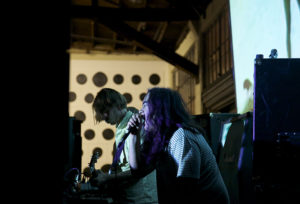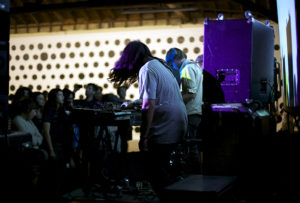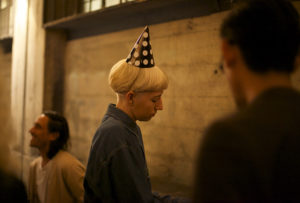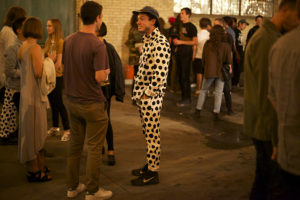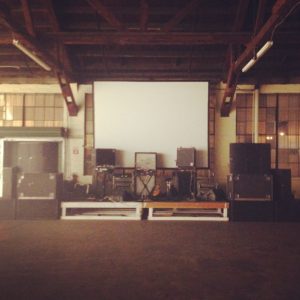Jonathan Horowitz “590 Dots” completion party with a performance by Black Dice
- Aaron Warren of Black Dice interviewed by Dorothy Dubrule, October 2014
Dorothy Dubrule: I often wonder about the relationship between technical mastery and experimentation. I think it is possible for expertise to get in the way of discovery. Do you ever wish you could unlearn a skill so that you could find a new way to do it, or is continually looking for alternative methods its own technique?
Aaron Warren: Ha yeah I am in no danger of mastering my skills as a musician. I am a perpetual amateur. It always feels like I’m learning how to do even the most rudimentary things for the first time. I think that was sorta what interested me, a few years back, about not playing guitar or bass but instead using samples and mixer and pedals the wrong way to make a really primitive keyboard-like instrument. I enjoy the challenge of getting basic sounds and basic structures set up by technology that was built for a different purpose than how I use it, and that sorta helps me distill ideas down into something a bit more essential.
DD: I’ve been thinking about the space between a recording and a live performance. If you consider the recording to be a score, and the performance to be a reading of that score, there’s a pretty wide spectrum of variation in how different bands “read” their scores. How would you characterize Black Dice’s reading style?
AW: Basically when we do the recording, that’s the best version of the tune we have at that time. Sometimes we’ve re-written it or whittled it down in studio, and then it becomes like you say, the score. But often it’s in the years after recording the jam that the song really comes to life and can be a thing that is open to interpretation every different time we play it. We know the songs inside out, and that gives us some leeway to stretch out, or not, and the song is usually way better than the recorded version. I think the band is always way better live than the records.
DD: Continuing to look at the relationship between your records and your shows, how do your structural strategies differ? Is a track list driven by predominately sonic concerns, while a live set list implies additional visual considerations?
AW: When we’re sequencing a record, there are some practical considerations. If you’re putting it on vinyl– 20-22 minutes a side, only certain combinations will work mathematically. Then each of us have super strong opinions as to the order of the songs based on our own unique histories of listening to thousands of records and how we each think a record should go. But we hash it out and it ends up living in its own way. For live sets, we approach it these days more like a dj set and think about what we’d want as audience members and craft the set with that in mind. Then we usually keep that set list as the “score” and the whole set becomes like a big song that’s open to interpretation depending on the vibe of the room and audience.
DD: I’ve heard that Jonathan Horowitz’s 590 dot paintings have been reinforced so that they won’t be shaken from the wall during your performance at the opening this Saturday. This is a testament to the spectacular sonic force of your live shows. What interests drive the visceral manner in which Black Dice occupies a space?
AW: Ever since I was a kid, if it’s rock n roll, it’s loud. And louder than is comfortable or safe. That’s exciting to me. I don’t go to a lotta shows these days, but when I do, I love to be able to feel the airwaves hitting my body. And ever since I was a kid, I’ve been seeing and playing in spaces that are not necessarily a rock club. But I love the idea of taking a rock n roll stadium mentality and putting that in a dude’s basement, or an elks hall, or an art gallery. And the contradictions of the performance versus the intended purpose can sometimes be straight magic. Sometimes it’s a disaster and stuff breaks and the power blows, or cops come and we look like clowns. But I think it’s a worthwhile challenge and we continue to try to do amazing DIY shows like this one.
Dorothy Dubrule is a LA-based choreographer and performance scholar
- Black Dice at 356 Mission


